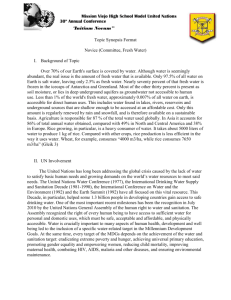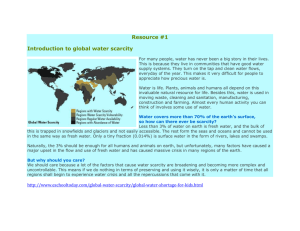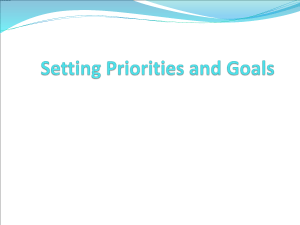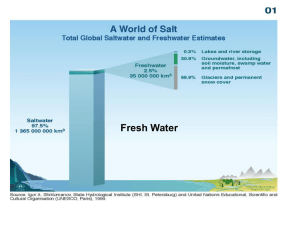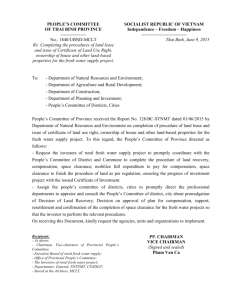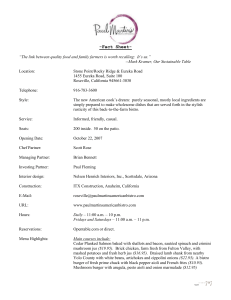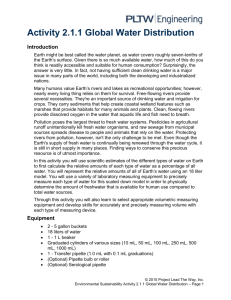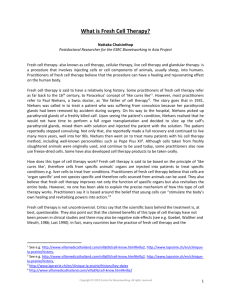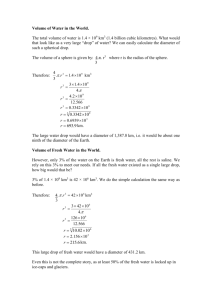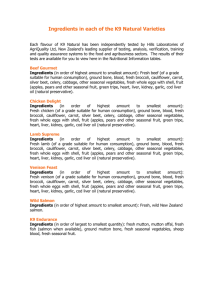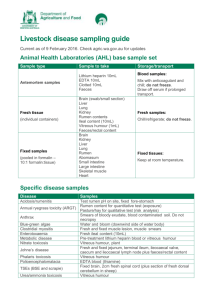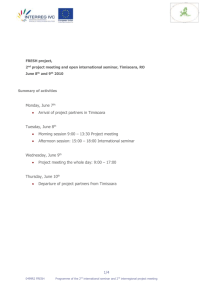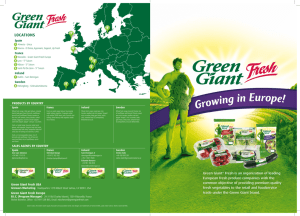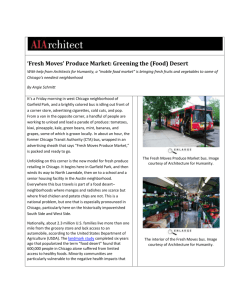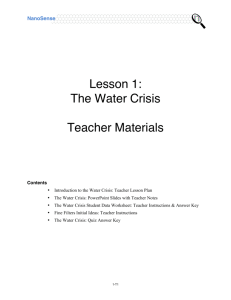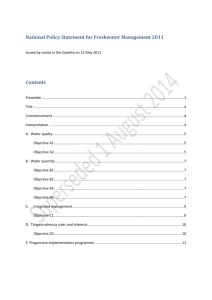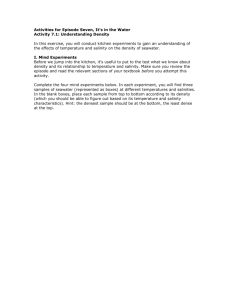Problem Memorandum – Water Scarcity
advertisement
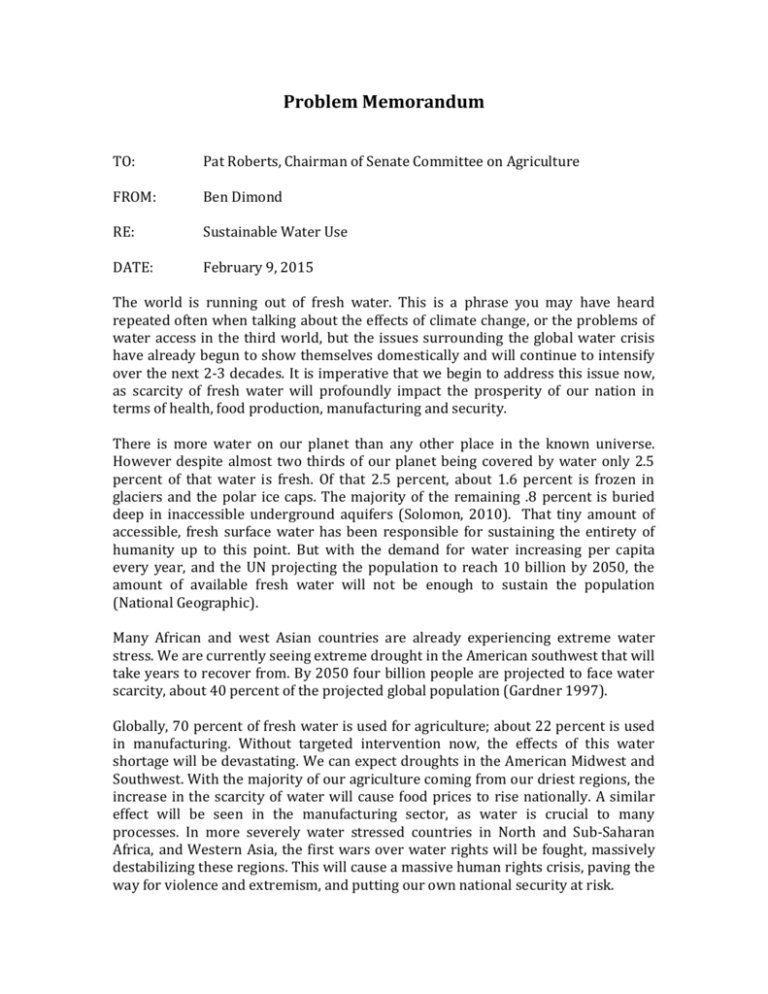
Problem Memorandum TO: Pat Roberts, Chairman of Senate Committee on Agriculture FROM: Ben Dimond RE: Sustainable Water Use DATE: February 9, 2015 The world is running out of fresh water. This is a phrase you may have heard repeated often when talking about the effects of climate change, or the problems of water access in the third world, but the issues surrounding the global water crisis have already begun to show themselves domestically and will continue to intensify over the next 2-3 decades. It is imperative that we begin to address this issue now, as scarcity of fresh water will profoundly impact the prosperity of our nation in terms of health, food production, manufacturing and security. There is more water on our planet than any other place in the known universe. However despite almost two thirds of our planet being covered by water only 2.5 percent of that water is fresh. Of that 2.5 percent, about 1.6 percent is frozen in glaciers and the polar ice caps. The majority of the remaining .8 percent is buried deep in inaccessible underground aquifers (Solomon, 2010). That tiny amount of accessible, fresh surface water has been responsible for sustaining the entirety of humanity up to this point. But with the demand for water increasing per capita every year, and the UN projecting the population to reach 10 billion by 2050, the amount of available fresh water will not be enough to sustain the population (National Geographic). Many African and west Asian countries are already experiencing extreme water stress. We are currently seeing extreme drought in the American southwest that will take years to recover from. By 2050 four billion people are projected to face water scarcity, about 40 percent of the projected global population (Gardner 1997). Globally, 70 percent of fresh water is used for agriculture; about 22 percent is used in manufacturing. Without targeted intervention now, the effects of this water shortage will be devastating. We can expect droughts in the American Midwest and Southwest. With the majority of our agriculture coming from our driest regions, the increase in the scarcity of water will cause food prices to rise nationally. A similar effect will be seen in the manufacturing sector, as water is crucial to many processes. In more severely water stressed countries in North and Sub-Saharan Africa, and Western Asia, the first wars over water rights will be fought, massively destabilizing these regions. This will cause a massive human rights crisis, paving the way for violence and extremism, and putting our own national security at risk. The world’s water problem has two elements: access and scarcity. The infrastructure does not currently exist to provide access to water for a large percentage of the population. By 2025 it is estimated that 230 million Africans will not have access to fresh water (Falkenmark, 1989). It is imperative to global stability that within the next 25 years the infrastructure is built up to the point that water can be supplied to the areas that will be hit the hardest, giving relief and easing tensions. The second and larger problem is scarcity. Today in 2015 we have allotted about 8 percent of accessible fresh water for domestic use. The vast majority of what is left about 70 percent of available fresh water is used for agriculture. We can meet the coming demand for fresh water by diverting some of the supply away from agriculture and toward domestic purposes. A 10 percent reduction in water use for agriculture (globally) would effectively double the supply available for households. This would be an important first step in a future of safe, sustainable water use. Thank you, Senator for taking the time to read this memo, I look forward to our future correspondence and any help I can provide you in this matter. Best Regards, Ben Dimond References Solomon, S. (2010). The Indispensable Resource. In Water: The epic struggle for wealth, power, and civilization (p. 12). New York: Harper. Clean Water Crisis, Water Crisis Facts, Water Crisis Resources - National Geographic. (n.d.). Retrieved February 9, 2015, from http://environment.nationalgeographic.com/environment/freshwater/freshwater-crisis/ Gardner-Outlaw T. and Engleman R., Sustaining Water, Easing Scarcity: A Second Update, 1997. Population Action International, Washington DC. Falkenmark M., Freshwater as a Factor in Strategic Policy and Action. In: Davis K., Bernstam M. and Sellers H. (eds.), Population and Resources in a Changing World, 1989. Morrison Institute for Population and Resource Studies, Stanford, California.


